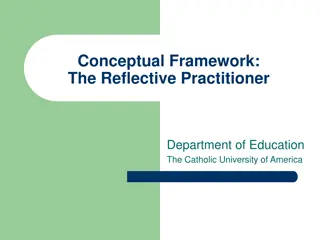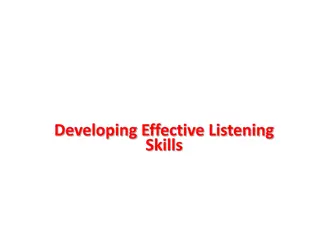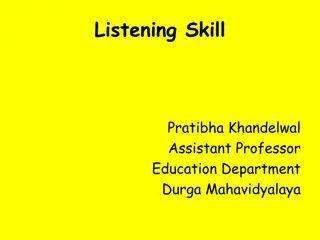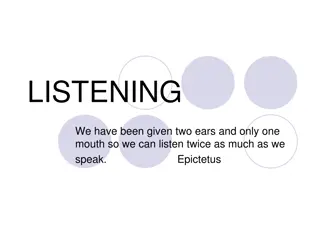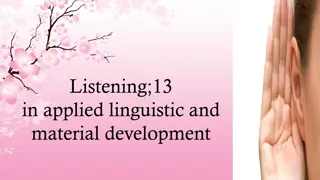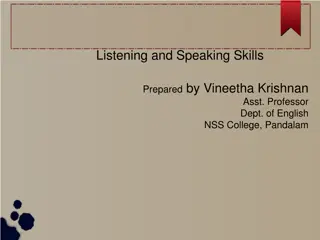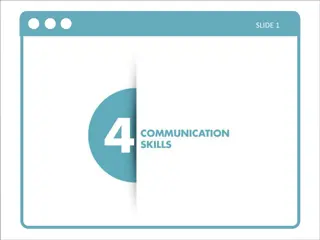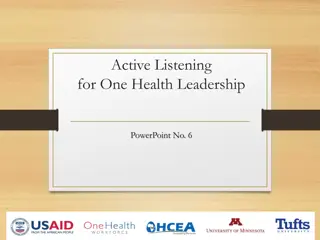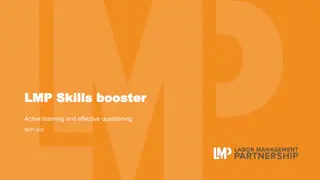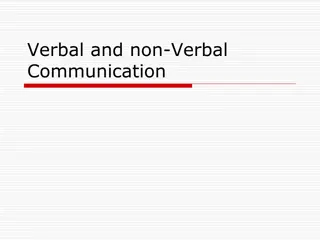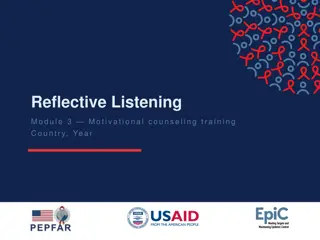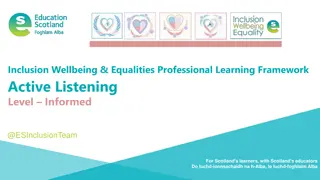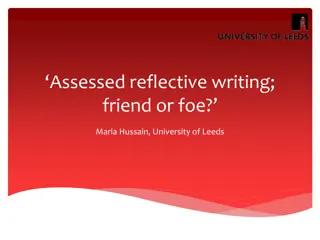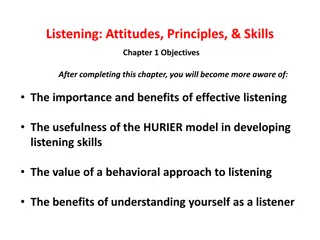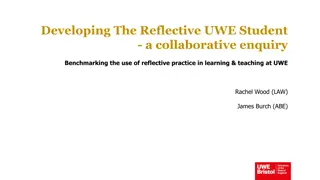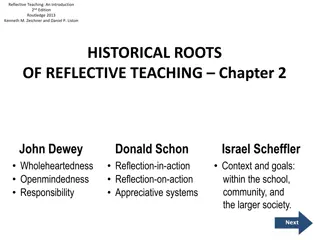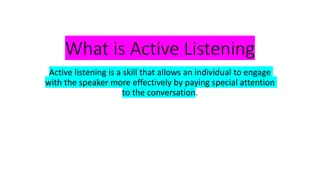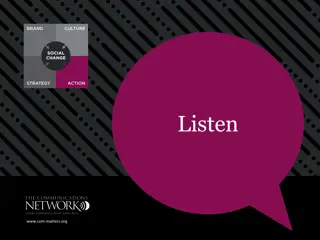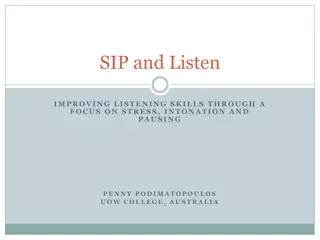Enhancing Communication Through Reflective Listening Techniques
The Reflective Listening process fosters effective communication by showing understanding, providing feedback, and guiding emotional expression. Skills like attending and reflective skills, as well as non-verbal cues like eye contact and gestures, play a crucial role. Silence can also be a powerful tool in encouraging deeper conversation. Acknowledgment responses, such as brief affirmations, help demonstrate active listening and support the speaker.
Download Presentation

Please find below an Image/Link to download the presentation.
The content on the website is provided AS IS for your information and personal use only. It may not be sold, licensed, or shared on other websites without obtaining consent from the author. Download presentation by click this link. If you encounter any issues during the download, it is possible that the publisher has removed the file from their server.
E N D
Presentation Transcript
THE REFLECTIVE LISTENING PROCESS OFFERS A NUMBER OF BENEFITS: 1. It lets the speaker know that she or he has been heard, understood, cared for, and supported. 2. It gives the other feedback on what he or she said and how it came across. 3. It allows you to check your own accuracy in hearing what the other has said. 4. It avoids the illusion of understanding. 5. It helps prevent the mental vacation in which you are inattentive during the conversation.
THE REFLECTIVE LISTENING PROCESS OFFERS A NUMBER OF BENEFITS: 6. It helps the other focus on self, vent, sort out issues, express feeling, and deal more effectively with emotions. 7. It allows the other to move to deeper levels of expression at his or her own pace. 8. It helps the other to think and articulate more clearly. 9. It helps the other arrive at a solution to his or her own problem. 10. It helps you clarify what you are expected to do. 11. It helps you deal effectively with the issue, problem and/or needs the other raised.
SKILLS Attending skills- non-verbally communicating that you are empathetic with the other. eyes, posture, nodding head, etc. Reflective skills- the skills of reflecting or expressing to the other the essence of the content and feelings you hear as well as summarizing larger segments of what is said.
NON-VERBAL Eye Contact: Eye contact indicates interest in the other person This does not mean that eye contact must be a fixed stare. Gestures: A great deal is communicate by body movements. Look out for: fidgeting, drum your fingers, cross your arms, sneak glances at your watch
SILENCE Interested Silence: A period of active, attentive silence serves as a gentle nudge to the other to move deeper into the conversation. It allows the other time to think and reflect and then comfortably proceed at his or her own pace. Giving the speaker time to experience and explore the feelings that churn up from within often enables him or her to explore their feelings at a deeper level. Silence is particularly useful in situations of loss or grief, such as the death of a loved one or a significant personal loss. Appropriate silence is useful in helping the other talk about a difficult problem.
ACKNOWLEDGMENT RESPONSES: Brief, one to three-word statement or nonverbal gestures. These response demonstrate to the speaker that you are following the conversations. Such response help the other know he or she is being listened to. Examples are: Um-humm. How about that! Uh-huh. Go on. Oh. Yeah. Sure. You did, eh? You betcha! Yes. No fooling! Sounds good. Right. Right on!
WHAT TO REFLECT REFLECTING CONTENT: Listening accurately to another person and reflecting the essence of the content to the other in your own words. REFLECTING FEELINGS: Listening accurately to another person and reflecting the feeling component of the communication to the other in your own words. REFLECTING MEANINGS: (combining feelings and content) Listening accurately to another person and reflecting the essence of both the content and the feelings the other has expressed.
WHAT TO REFLECT SUMMARIZING Listening accurately to another person and reflecting the main points of the other s communication. Summarizing condenses all of what a person has said into two or three sentences.
THE REFLECTING PROCESS INVOLVES 4 STEPS: 1. Taking in Cues: As another communicates, you listen for and record cues in three areas: Content The words actually stated and meaning of those words. Feelings The feelings stated or implied in the communication. Context The material you know or are aware of that related to the communication but isn t communicated: where it is being said, other information he or she has related to you in the past, 2. Sorting: Sifting through the cues to arrive at a judgement about the essence of a particular chunk of the communication. 3. Drawing a conclusion: Determining what the essence of the communication is. Formulating a sentence to yourself about what you think the speaker is trying to say. 4. Expressing the essence: Stating the essence of a chunk of the communication to the other in your own words in order to check out whether or not you are understanding the other.
KINDS OF REFLECTIONS Simple: Stays close to what the patient said Complex: Goes beyond what the person said and doesn t use the same words; often cognitively reframes the material, infers greater meaning, and may include affect Amplified: pushes on an absolute statement by the person; may back the person away from their position Double-sided: acknowledges both sides of an argument Metaphor: moves beyond content to provide model for understanding.


